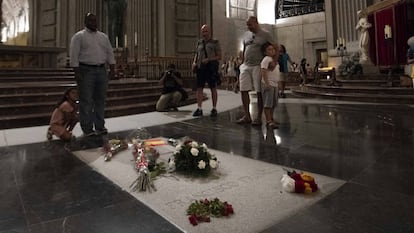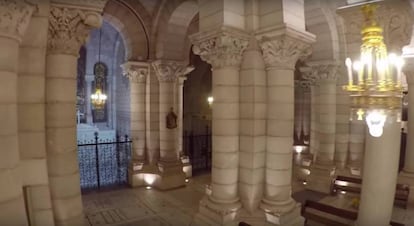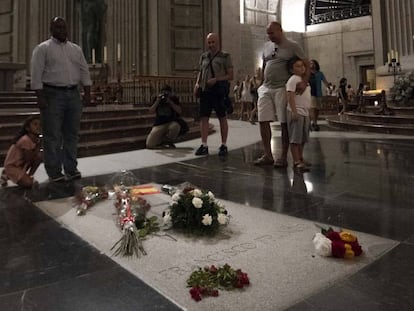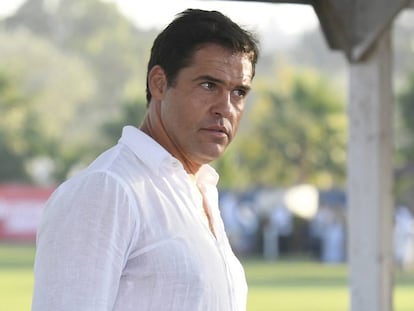Spanish PM wants Vatican to help stop Franco from being reburied at Madrid cathedral
The deputy prime minister will go to the Holy See to try to prevent the dictator’s body from resting next to the Royal Palace

The exhumation of Spanish dictator Francisco Franco from the Valley of the Fallen monument is becoming increasingly complicated for the Socialist Party (PSOE) government. The family of the dictator wants his body to be reburied in La Almudena cathedral, located in downtown Madrid next to the Royal Palace. But this would undermine the purpose of the exhumation and risk turning the proposed resting place, which is frequently visited by tourists, into a new and more accessible pilgrimage site for the dictator’s supporters.
It is not a problem for the archbishop or for the Church
Madrid archbishop Carlos Osoro
The government would prefer Franco’s remains to be moved to a more discreet location – for instance the El Prado cemetery, where his wife is buried – but it has yet to find a legal avenue to block the move. The Franco family bought a crypt “for life” underneath La Almudena cathedral, and that is where his daughter, Carmen Franco, was buried in 2017.
With no legal grounds to prevent the move, the government is turning to the Vatican for help. Deputy Prime Minister Carmen Calvo will travel to Rome to meet with Pietro Parolin, the pope’s right-hand man. The goal of the trip is not to ask the Catholic Church to stop Franco from being reburied in the landmark cathedral, but to discuss the issue more generally, according to the government.
The deputy prime minister also plans to discuss properties that appear to be fraudulently owned by the Catholic Church, including the Mosque-Cathedral of Córdoba (which was put in the Church’s name in 2006 for €30 thanks to a law approved under Franco), public squares, country houses and even the top of a mountain in the Basque Country.

The government also depends on the Church to support Franco’s exhumation. The archbishop of Madrid, Carlos Osoro, agreed not to prevent the exhumation from the Valley of the Fallen in July, but has said the Church cannot stop Franco’s family from moving his remains to La Almudena.
“We have no problem in taking in anybody. Franco has a property and, naturally, like any Christian, he has the right to be buried where it is convenient for the family,” Osoro said on October 1. “It is not a problem for the archbishop or for the Church.”
I prefer Franco to be in the Valley of the Fallen than in La Almudena, next to the Royal Palace
Carlos García de Andoain, secretary of expert committee
If the government does find a legal avenue to stop the transfer, the Church is likely to accept the order, as it did with the exhumation from the Valley of the Fallen. But it has found no legal argument, other than for security reasons, which could be rejected by the courts – an outcome that would be a significant blow to the government, which made moving Franco’s remains one of its first promises.
Sources close to the archbishop of Madrid say the Church is also concerned about the Franco family’s decision to move the dictator’s remains to La Almudena, fearing it could repel Christians and attract protests.
“This is a masterstroke from the Franco family, and the government has been a bit naïve. The situation is diabolical,” says Carlos García de Andoain, the secretary of the expert committee that first looked at exhuming Franco’s remains in 2011. “I prefer Franco to be in the Valley of the Fallen than in La Almudena, next to the Royal Palace.”
The government foresaw the legal challenges the family could use to stop the exhumation and was able to block them with a decree approved by Congress. But it did not expect the problem with La Almudena, and having promised to remove Franco’s remains by the end of the year, it is running out of time to solve it.
English version by Melissa Kitson.
Tu suscripción se está usando en otro dispositivo
¿Quieres añadir otro usuario a tu suscripción?
Si continúas leyendo en este dispositivo, no se podrá leer en el otro.
FlechaTu suscripción se está usando en otro dispositivo y solo puedes acceder a EL PAÍS desde un dispositivo a la vez.
Si quieres compartir tu cuenta, cambia tu suscripción a la modalidad Premium, así podrás añadir otro usuario. Cada uno accederá con su propia cuenta de email, lo que os permitirá personalizar vuestra experiencia en EL PAÍS.
¿Tienes una suscripción de empresa? Accede aquí para contratar más cuentas.
En el caso de no saber quién está usando tu cuenta, te recomendamos cambiar tu contraseña aquí.
Si decides continuar compartiendo tu cuenta, este mensaje se mostrará en tu dispositivo y en el de la otra persona que está usando tu cuenta de forma indefinida, afectando a tu experiencia de lectura. Puedes consultar aquí los términos y condiciones de la suscripción digital.
More information
Archived In
Últimas noticias
Raúl Rocha, from jet-setting with Miss Universe to arms trafficking and fuel theft
80,000 barrels of Mexican oil sent to Cuba: Havana drawn into the US–Mexico clash
Human rights activists, opposition members, and a minor: Maduro’s other political prisoners
Israel sparks a civil war within the MAGA movement
Most viewed
- Reinhard Genzel, Nobel laureate in physics: ‘One-minute videos will never give you the truth’
- Pablo Escobar’s hippos: A serious environmental problem, 40 years on
- Charles Dubouloz, mountaineering star, retires at 36 with a farewell tour inspired by Walter Bonatti
- Why we lost the habit of sleeping in two segments and how that changed our sense of time
- The fall of a prolific science journal exposes the billion-dollar profits of scientific publishing










































